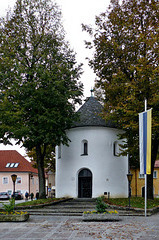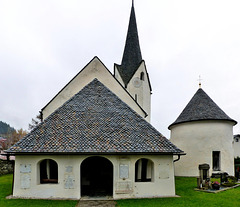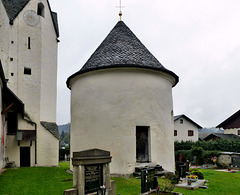
Carinthia / Kaernten
All photos were taken in Carinthia, the southernmost Austrian state.
Sankt Veit an der Glan - Sankt Veit
| |
|
|
The parish church is mentioned first time in 1131, then belonging to the Diocese of Gurk, but in 1137 the place was "acquired" by the Diocese of Bamberg, like so many places and villages in Carinthia.
The once Romanesque building burned down in 1829 and got rebuilt within the 19th century.
The round karner (ossuary), next to the church, erected within the 12th or 13th century survived the fire.
Sankt Veit an der Glan - Buergerspital
| |
|
This complex of buildings was mentioned the first time in 1321 as "hospitale extramuros de sancto Vito". The hospital (dedicated to St. Veit) is in deed located just outside (extramuros) the old town.
The buildings got altered in the 17th and after a fire in the 19th century. Unfortunately the Gothic church was already locked.
Sankt Veit an der Glan - Buergerspital
| |
|
Sankt Veit an der Glan - BuergerspitalThis complex of buildings was mentioned the first time in 1321 as "hospitale extramuros de sancto Vito". The hospital (dedicated to St. Veit) is in deed located just outside (extramuros) the old town.
The buildings got altered in the 17th and after a fire in the 19th century. Unfortunately the Gothic church was already locked, the tympanum depicts a suffering Jesus, what may have given some comfort to the sick.
Sankt Veit an der Glan - Kunsthotel Fuchspalast
| |
|
|
Returning to the hotel late at night. The hotel, glowing in the dark, was designed by Austrian artist Ernst Fuchs, member of the "Vienna School of Fantastic Realism". The rooms are comfortable and agreeable.
www.hotel-fuchspalast.at/english/
Hoerzendorf - Sankt Georg
| |
|
|
The parish church of Hoerzendorf, mentioned the first time in 1087, was locked. The rectangular Karner (ossuary) on the right dates to the 12th century.
Glantschach - Sankt Andreas
| |
|
The church and the round Karner (ossuary), surrounded by the graveyard, are located right in the center of the little village (pop >400). The first church was erected here between 958 and 991 and so is one of oldest in the area. Some walls of this building may still exist and be part of the church seen today.
The round Karner is dated to the 12th century.
Glantschach - Sankt Andreas
| |
|
|
The church and the round Karner (ossuary), surrounded by the graveyard, are located right in the center of the little village (pop >400). The first church was erected here between 958 and 991 and so is one of oldest in the area. Some walls of this building may still exist and be part of the church seen today. The large nathex is of course younger.
The round Karner is dated to the 12th century.
Glantschach - Sankt Andreas
| |
|
The church and the round Karner (ossuary), surrounded by the graveyard, are located right in the center of the little village (pop > 400). The first church was erected here between 958 and 991 and so is one of oldest in the area. Some walls of this building may still exist and be part of the church seen today.
The round Karner is dated to the 12th century.
Glantschach - Sankt Andreas
| |
|
|
The church and the round Karner (ossuary), surrounded by the graveyard, are located right in the center of the little village (pop > 400). The first church was erected here between 958 and 991 and so is one of oldest in the area. Some walls of this building may still exist and be part of the church seen today.
The round Karner has a little apse. The Karner was erected in the 12th century.
Protected under a little roof on the southern wall is a large "Christopherus". Between his legs swims a crowned mermaid.
Pulst - Maria Pulst
| |
|
The parish church of Pulst is dedicated to the "Assumption of Mary", but is known under the name "Maria Pulst".
My guidebooks told me, that inside the nave of the Gothic church from the 15th century is a wonderful frescoe depicting the Adoration of the Magi, but the unfortunately the church was locked. The rectangular Karner (ossuary) with the small apse is older than the church. probably 13th century.
Wörthersee
| |
|
|
Wörthersee is Carinthia's largest lake, flanked by the foothills of the Gurktal Alps and the Karawanks. The area around the lake was a summer retreat for Vienna's wealthy nobility in the second half of the 19th century. In the 1950s mass tourism started - and the lake became a popular tourist destination in summer, due to the Mediterranean climate and the clean, warm waters. In cold and foggy autumn there are only very few tourists around here.
Maria Wörth
| |
|
|
|
During the Christianization of Carinthia, that had started in the 8th century, monks from the Innichen Abbey (today South Tyrol, Italy) worked here on behalf of the Diocese of Freising. Bishop Waldo of Freising had the first church built here. This was first mentioned in an 894 deed as Maria Werd. "Werd" is an old German word for island - and this place was an island at that time.
Later the relics of Saint Primus and Saint Felician were translated to this church and around 1150 Otto I of Freising founded a college of canons here. He as well had another smaller church, named "Winterkirche" built aside the collegiate church. Both churches burnt down in 1399 and afterwards got rebuilt in the late Gothic style, seen today.
Maria Wörth
| |
|
|
During the Christianization of Carinthia, that had started in the 8th century, monks from the Innichen Abbey (today South Tyrol, Italy) worked here on behalf of the Diocese of Freising. Bishop Waldo of Freising had the first church built on the highest point of the small island. This church was first mentioned in an 894 deed as Maria Werd. "Werd" is an old German word for island.
Later the relics of Saint Primus and Saint Felician were translated to this church and around 1150 Otto I of Freising founded a college of canons here. He as well had another smaller church, named "Winterkirche" built aside the collegiate church. Both churches burnt down in 1399 and afterwards got rebuilt in the late Gothic style, seen today.
Here is the choir of the Gothic church - and the round Karner (ossuary). The Karner, consecrated in 1279, survived the blaze of 1399.
Maria Wörth
| |
|
During the Christianization of Carinthia, that had started in the 8th century, monks from the Innichen Abbey (today South Tyrol, Italy) worked here on behalf of the Diocese of Freising. Bishop Waldo of Freising had the first church built on the highest point of the small island. This church was first mentioned in an 894 deed as Maria Werd. "Werd" is an old German word for island.
Later the relics of Saint Primus and Saint Felician were translated to this church and around 1150 Otto I of Freising founded a college of canons here. He as well had another smaller church, named "Winterkirche" built aside the collegiate church. Both churches burnt down in 1399 and afterwards got rebuilt in the late Gothic style, seen today.
The round Karner (ossuary), consecrated in 1279, survived the blaze of 1399.
Maria Wörth
| |
|
During the Christianization of Carinthia, that had started in the 8th century, monks from the Innichen Abbey (today South Tyrol, Italy) worked here on behalf of the Diocese of Freising. Bishop Waldo of Freising had the first church built on the highest point of the small island. This church was first mentioned in an 894 deed as Maria Werd. "Werd" is an old German word for island.
Later the relics of Saint Primus and Saint Felician were translated to this church and around 1150 Otto I of Freising founded a college of canons here. He as well had another smaller church, named "Winterkirche" built aside the collegiate church. Both churches burnt down in 1399 and afterwards got rebuilt in the late Gothic style, seen today.
Under Gothic rib vaults are Baroque altars and a massive pulpit.
Maria Wörth
| |
|
During the Christianization of Carinthia, that had started in the 8th century, monks from the Innichen Abbey (today South Tyrol, Italy) worked here on behalf of the Diocese of Freising. Bishop Waldo of Freising had the first church built on the highest point of the small island. This church was first mentioned in an 894 deed as Maria Werd. "Werd" is an old German word for island.
Later the relics of Saint Primus and Saint Felician were translated to this church and around 1150 Otto I of Freising founded a college of canons here. He as well had another smaller church, named "Winterkirche" built aside the collegiate church. Both churches burnt down in 1399 and afterwards got rebuilt in the late Gothic style, seen today.
Under the choir of today´s church is a crypt, that may have been the crypt of the preceding Romanesque church.
Maria Wörth
| |
|
During the Christianization of Carinthia, that had started in the 8th century, monks from the Innichen Abbey (today South Tyrol, Italy) worked here on behalf of the Diocese of Freising. Bishop Waldo of Freising had the first church built on the highest point of the small island. This church was first mentioned in an 894 deed as Maria Werd. "Werd" is an old German word for island.
Later the relics of Saint Primus and Saint Felician were translated to this church and around 1150 Otto I of Freising founded a college of canons here. He as well had another smaller church, named "Winterkirche" built aside the collegiate church. Both churches burnt down in 1399 and afterwards got rebuilt in the late Gothic style, seen today.
The small "Winterkirche".
Maria Wörth
| |
|
|
|
During the Christianization of Carinthia, that had started in the 8th century, monks from the Innichen Abbey (today South Tyrol, Italy) worked here on behalf of the Diocese of Freising. Bishop Waldo of Freising had the first church built on the highest point of the small island. This church was first mentioned in an 894 deed as Maria Werd. "Werd" is an old German word for island.
Later the relics of Saint Primus and Saint Felician were translated to this church and around 1150 Otto I of Freising founded a college of canons here. He as well had another smaller church, named "Winterkirche" built aside the collegiate church. Both churches burnt down in 1399 and afterwards got rebuilt in the late Gothic style, seen today.
The apse of the small "Winterkirche" (aka "Rosenkranzkirche") still has some frescoes.
Jump to top
RSS feed- Latest items - Subscribe to the latest items added to this album
- ipernity © 2007-2024
- Help & Contact
|
Club news
|
About ipernity
|
History |
ipernity Club & Prices |
Guide of good conduct
Donate | Group guidelines | Privacy policy | Terms of use | Statutes | In memoria -
Facebook
Twitter


















